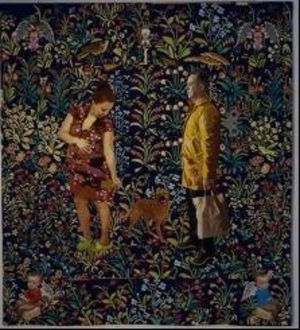A RECIPE: MAKING MEANINGS IN THE EVERYDAY 5
Ingredients:
Monotonous daily work – 3 years;
History and mysticism – 4 sources;
Unconscious wishes – ∞;
Symbolism – to education;
Irony – to taste.
In brief: The textile artist Vita Gelūnienė’s tapestry ‘The Hunt of the Unicorn’ (2010-11) could be called a result of a monotonous work. The author chose a classical Gobelin weaving, which associates with a continuous interweaving of seams. A repetitive act becomes monotonous with clear links to the everyday. A colourful tapestry reveals domestic characters – a pregnant woman with slippers or a clockwork potbelly with a shopping bag. The idyllic subject was named mystically – ‘The Hunt of the Unicorn’.
The title was inspired by the 15-16 century Gobelin collections that often involve a unicorn as a symbol of innocence, purity and happiness. On the other hand, unicorn’s pointed, long horn is a phallic symbol. The ‘hunt’ refers to killing and preying – an act evoking satisfaction. The title of the work reflects the desire for the phallus, the wish to experience satisfaction and acquire power. Since the work is created by a woman, arguably, it is an attempt to possess a patriarchal dominion; the content of the tapestry could be called latent.
Interestingly, no unicorn is depicted in the tapestry. A brown dog takes its place in the centre as a symbol of courage, sacrifice and loyalty. It is conveyed as a guardian, looking straight at the viewer, as if warning not to approach too close. Mythical qualities are given to the dog as a sign of the everyday.
According to S. Freud, a girl destitute of penis feels as if she lost something valuable. She can compensate the shortage by becoming a woman and giving birth to a child, especially a boy.
The image of the clockwork man also highlights the desire for power. A toy-like figure of the man becomes dependent and controlled. The author expressed the dominance of woman and decline of patriarchal power by mechanising the man‘s figure.
In 15-16 century tapestries the unicorn and the maiden would represent lovers and the hunter – symbol of love. Their relation would be strengthened by a contact – the maiden was often depicted touching the horn and the hunter – stabbing the spear into the unicorn‘s heart. There is no physical connection, looking nor touching each other between figures in V. Gelūnienė‘s tapestry. The fusion could be felt only in the style of mille-fleurs: floral patterns dominate in the background and on the figures of the woman and man. Referring to Freud, flower blossoms mark female genitals; that is why a female sexual energy dominates in the tapestry.
Symbols, secret unconscious desires and stories are covered behind the idyllic subject of ‘The Hunt of the Unicorn’. They colour our daily-round and stimulate lust and desires.









